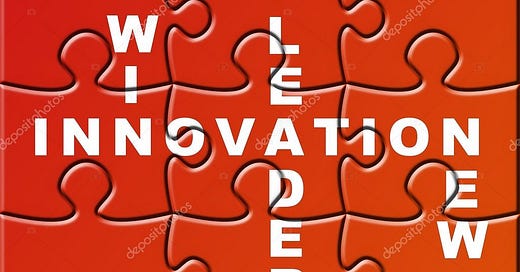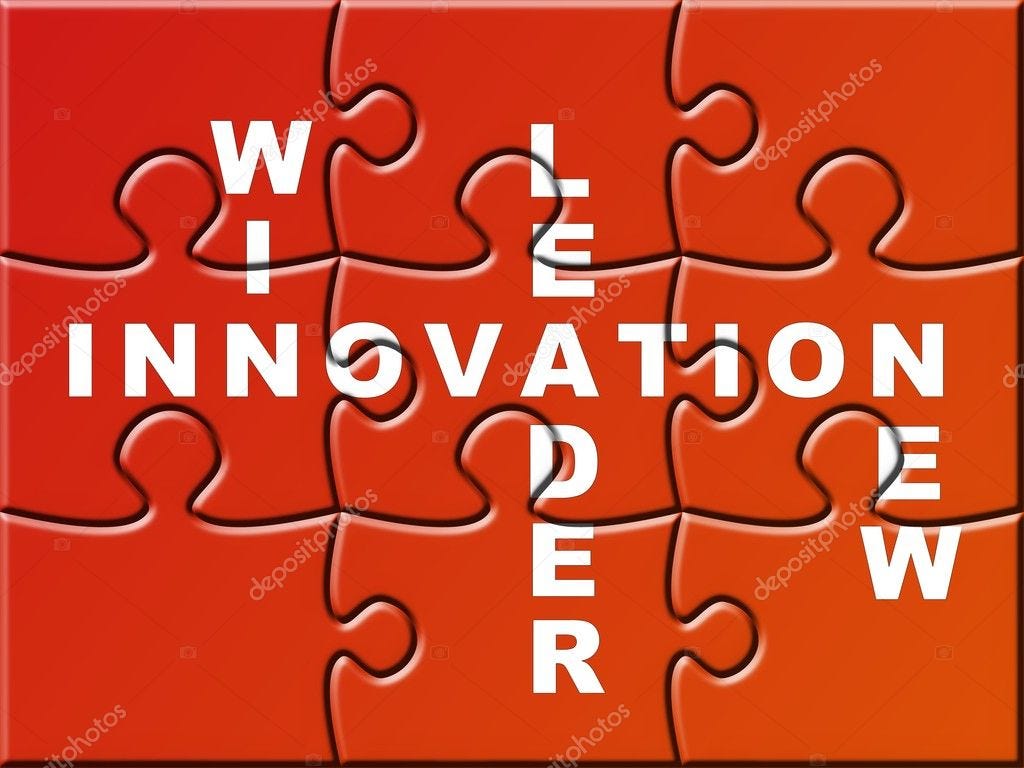Technological Innovation is like solving a jigsaw puzzle
Innovation consists of combining small pieces to make a more useful bigger piece.
Technological Innovation Is Like Solving a Jigsaw Puzzle
An interesting analogy for technological innovation is trying to solve a jigsaw puzzle. Each piece of the puzzle represents an existing technology. The finished puzzle represents new technology.
Jigsaw puzzles typically come in boxes that contain all the necessary pieces for completing the puzzle, along with a photo of the completed puzzle on the cover. This photo gives the puzzle-solver important clues as to a general location where a specific piece might be located. Light blue pieces might be a portion of the sky, which is up near the top of the puzzle. Orange pieces might be the sun in the top right. Generally, one person sits down for an extended period to complete the puzzle, and when it is done that person might admire it for a while, but ultimately the final product goes back into the box.
The reason why a jigsaw puzzle is an apt analogy for technological innovation is that technology is combinatory and modular (as we saw earlier). Assembling a puzzle resembles combining separate pieces of technology to create a finished product.
Innovation is the opposite of breaking down technology into its components, sub-components, and materials. Technological innovation is about assembling existing technologies to form something that has never existed before. Each component, sub-component, and material already existed before the new technology existed, but together they make something unique, and hopefully useful. A new technology is, therefore, the first instance of a unique combination of two or more existing technologies.
The following is an excerpt from my book From Poverty to Progress: Understanding Humanity’s Greatest Achievement. You can purchase discounted copies of my book at my website, or pay full price at Amazon.
Other books in my “From Poverty to Progress” book series:
See also my other articles on Technology and Innovation:
Technological Innovation is like solving a jigsaw puzzle (this article)
Book review: "The Nature of Technology: What It Is and How It Evolves" by W. Brian Arthur (podcast)
But as we explore the analogy deeper, we notice that technological innovation involves a very different process to an individual solving a jigsaw puzzle. Innovation is different from a typical jigsaw puzzle in that:
Innovation is far more likely to be a made by a group of people than an individual. Despite history books being full of heroic individuals, such as Tesla, Edison, Ford and Jobs, innovation in the real world always involves many people, most of whom are not mentioned in the history books.
A jigsaw puzzle is not useful after it is finished. It is usually taken apart and then put back in its box. A new technology, however, is potentially useful if it performs a task better or more cheaply than existing technology. This means that it persists long after the “puzzle” is completed.
Even more importantly, a new technology becomes a potential component in future technologies. A new type of engine, software, hardware component or material can potentially be used in many technologies. Doing so creates the first instance of a new technology.
A puzzle has a front cover that helps people understand how all the pieces fit together. Technological innovation, however, has no equivalent. This makes creating new technology far harder than assembling a puzzle. People first must “design” how the pieces fit together before they can complete the puzzle. The design is an educated guess as to which pieces are necessary and roughly how they fit together.
A puzzle has exactly the right number and type of pieces. In technology, however, there are far more potential component technologies than are necessary to create a new technology. Some may appear to be useful in assembling the puzzle but are not. Others may look unimportant but are, in fact, key pieces of the puzzle.
In technological innovation, some of the “puzzle pieces” may be missing (for instance when a necessary component has not yet been invented). This missing piece then becomes its own puzzle that must be finished before the bigger puzzle can be completed.
If there is only one “missing piece”, it may be relatively easy to conceive of and design it. This makes the primary problem one of implementation. But if there are multiple missing pieces, the “shape” of each of those pieces is unknown.
In other words, it may be difficult for people to even conceive of each of the component technologies that need to be created. This makes it unlikely that the new technology can be created. Someone else may need to create a component, and then another team at a later date may try to resolve the problem. Because all the pieces are available on the second try, the “puzzle” can now be completed.
In puzzle building, each person knows about all of the puzzle pieces. In technological innovation, however, each person has an understanding of the proper use of only a few technologies. As the innovation of new technologies requires an understanding of numerous potential component technologies, this puts a serious limitation on the ability of one person working alone to create new technology. Therefore, a group with a diverse skill set has an advantage over an individual or a homogeneous group, whose members all have the same skill set.
People work on jigsaw puzzles in their free time, because it is fun. This limits the amount of time that most people devote to puzzle building. While many people find creating new technology fun, the vast majority who work on technology are paid to work full-time. This greatly increases the total number of man-hours devoted to innovating technology. Each man-hour devoted to solving a problem increases the chance that it will be solved.
Puzzle building is usually limited to one person or a set group of people. In technological innovation, however, people often realize that their group is missing a key skill but they know other individuals who possess that skill. Therefore, the more connected innovators are, the more opportunity they have to know a person who can help.
In puzzle building, the shape of each piece is fixed and it is considered cheating to change its shape to make it fit properly. In technological innovation, it is not unusual to modify a component technology so that it functions better within the new technology.
Doing so contributes to innovation in four ways. First, the modified component is effectively a new technology. Second, the new piece enables the higher technology to be created, effectively a second technology. Third, the modified component can be used to improve other technologies that were using the unmodified component. Finally, the modified component may turn out to be a key component that leads to one or more technological innovations.
The above is an excerpt from my book From Poverty to Progress: Understanding Humanity’s Greatest Achievement. You can purchase discounted copies of my book at my website, or pay full prize at Amazon.
See also my other articles on Technology and Innovation:
Technological Innovation is like solving a jigsaw puzzle (this article)
Book review: "The Nature of Technology: What It Is and How It Evolves" by W. Brian Arthur (podcast)






